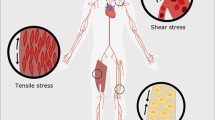Abstract
Low energy electromagnetic fields (EMF) exhibit a large number of biological effects. A major issue to be determined is “What is the lowest threshold of detection in which cells can respond to an EMF?” In these studies we demonstrate that a low-amplitude combined magnetic field (CMF) which induces a maximum potential gradient of 10-5 V/m is capable of increasing net calcium flux in human osteoblast-like cells. The increase in net calcium flux was frequency dependent, with a peak in the 15.3–16.3 Hz range with an apparent bandwidth of approximately 1 Hz. A model that characterizes the thermal noise limit indicates that nonspherical cell shape, resonant type dynamics, and signal averaging may all play a role in the transduction of lowamplitude EMF effects in biological systems.
Similar content being viewed by others
References
Sagan LA (1992) Epidemiological and laboratory studies of power frequency electric and magnetic fields. JAMA 268:625–629
Luben RA (1991) Effects of low-energy electromagnetic fields (pulsed and dc) on membrane signal transduction processes in biological systems. Health Phys 61:15–28
Pollack SR (1984) Bioelectrical properties of bone. Orthop Clin NA 15:3–14
Bassett CAL, Becker RO (1962) Generation of electric potentials by bone in response to mechanical stress. Science 137:1063–1064
Cadossi R, Bersani F, Cossarizza A, Zucchini P, Emilia G, Torelli G, Franceschi C (1992) Lymphocytes and electromagnetic fields. FASEB J 6:2667–2674
Walleczek J, Budinger TF (1992) Pulsed magnetic field effects on calcium signaling in lymphocytes: dependence on cell status and field intensity. FEBS Lett 314:351–355
Ozawa H, Abe E, Shibaski Y, Fukuhara T, Suda T (1989) Electric fields stimulate DNA synthesis of mouse osteoblast-like cells (MC3T3) by a mechanism involving calcium ions. J Cell Physiol 138:477–483
Yost MG, Liburdy RP (1992) Time-varying and static magnetic fields act in combination to alter calcium signal transduction in the lymphocyte. FEBS Lett 296:117–122
Rozek RJ, Sherman ML, Liboff AR, McLeod BR, Smith SD (1987) Nifedipine is an antagonist to cyclotron resonance enhancement of 45-calcium incorporation into human lymphocytes. Cell Calcium 8:413–427
Berridge MJ (1993) Inositol trisphosphate and calcium signaling. Nature 361:315–325
Farley JR, Hall SL, Herring S (1993) Calcitonin acutely increases net 45Ca uptake and alters ALP specific activity in human osteosarcoma cells. Metabolism 42:97–104
Sato N, Wang X, Greer MA (1992) Protein kinase C modulates cell swelling-induced calcium flux and prolactin secretion in GH4C1 cells. Mol Cell Endocrinol 86:137–142
Fitzsimmons RJ, Strong D, Mohan S, Baylink DJ (1992) Lowamplitude, low-frequency electric field-stimulated bone cell proliferation may in part be mediated by increased IGF-II release. J Cell Physiol 150:84–89
Zhang K, Papageorge AG, Lowy DR (1992) Mechanistic aspects of signaling through Ras in NIH 3T3 cells. Science 257:671–674
Farley JR, Wergedal JE, Hall SL, Herring S, Tarbaux NM (1991) Calcitonin has direct effects on 3H-thymidine incorporation and ALP activity in human osteoblast-line cells. Calcif Tissue Int 48:297–301
Bradford MM (1976) A rapid and sensitive method for quantitation of microgram amounts of protein utilizing the principle of protein-dye binding. Anal Biochem 72:248–255
Weaver JC, Astumian RD (1990) The response of living cells to very weak electric fields: the thermal noise limit. Science 247: 459–462
Pilla AA (1993) State of the art in electromagnetic therapeutics. In: Blank M (ed) Electricity and magnetism in biology and medicine. San Francisco Press, San Francisco, pp 17–22
Fitzsimmons RJ, Baylink DJ, Ryaby JT, Magee FP (1993) EMF-stimulated bone-cell proliferation. In: Blank M (ed) Electricity and magnetism in biology and medicine. San Francisco Press, San Francisco, pp 899–901
McLeod KJ, Lee RC, Ehrlich HP (1987) Frequency dependence of electric field modulation of fibroblast protein synthesis. Science 236:1465
Kalmun AJ (1982) Electric and magnetic field detection in elasmobranch fishes. Science 218:916–918
Tenforde TS (1992) Microscopic dosimetry of extremely lowfrequency electric and magnetic fields. Bioelectromagnetics (suppl) 1:61–66
McLeod BR, Liboff AR (1987) Cyclotron resonance in cell membranes: the theory of the mechanism. In: Blank M, Findl E, (eds) Mechanistic approaches to interactions of electric and electromagnetic fields with living systems. Plenum Press, New York, 97
Halle B (1988) On the cyclotron resonance mechanism for magnetic field effects on transmembrane conductivity. Bioelectromagnetics 9:381–388
Adair RK (1991) Constraints on biological effects of weak extremely low-frequency electromagnetic fields. Phys Rev A 43: 1039–1048
McLeod BR, Liboff AR, Smith SD (1992) Electromagnetic gating in ion channels. J Theor Biol 158:15–31
Bianco B, Chiabrera A (1992) From the Langevin-Lorentz to the Zeeman model of electromagnetic effects on ligand-receptor binding. Bioelectrochem Bioenerg 28:355–363
Lednev VV (1991) Possible mechanism for the influence of weak magnetic fields on biosystems. Bioelectromagnetic 12:71–75
Edmonds DT (1993) Larmor precession as a mechanism for the detection of static and alternating magnetic fields. Bioelectrochem Bioenerg 30:3–12
Bassett CAL, Chohski HR, Hernandez E, Pawluk RJ, Strop M (1979) The effect of pulsing electro-magnetic fields on cellular calcium anc calcification of nonunions. In: Brighton CT, Black J, Pollack SR (eds) Electrical properties of bone and cartilage. Grune and Stratton, New York, pp 427–441
Fukayama S, Tashjian AH (1990) Stimulation by parathyroid hormone of 45Ca uptake in osteoblast-like cells: possible involvement of alkaline phosphatase. Endocrinology 126:1941–1949
Author information
Authors and Affiliations
Rights and permissions
About this article
Cite this article
Fitzsimmons, R.J., Ryaby, J.T., Magee, F.P. et al. Combined magnetic fields increased net calcium flux in bone cells. Calcif Tissue Int 55, 376–380 (1994). https://doi.org/10.1007/BF00299318
Received:
Accepted:
Issue Date:
DOI: https://doi.org/10.1007/BF00299318




